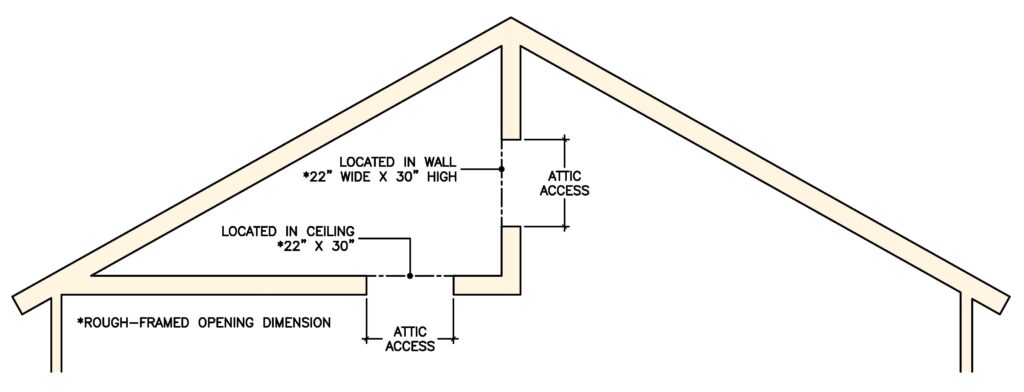Lets get straight to the point.
The attic access requirements for residential structures can be found in Section R807.1 of the 2018 International Residential Code.
Due to the likelihood of requiring access to the attic space for repairs and maintenance during the life of a home, the code establishes the minimum requirements for attic access to ensure it is functional and safe.
In addition to this, it is a convenient way for fire department personnel to gain entry into a concealed space, such as an attic, and address any potential fire hazards.
Therefore let us cover the 5 main things you should know when it comes to attic access openings per the International Residential Code.
1. Attic Access Requirements
When is an Attic Access Required?
Section R807.1 requires buildings with combustible ceiling or roof construction to have an attic access opening to the attic areas that have a vertical height of 30 inches or greater over an area of no less than 30 square feet.

It is important to note here that the vertical height is measured from the top of the ceiling joist to the underside of the roof rafter.
2. Attic Access Location
Where should the Attic Access Opening be Located?
The opening for the attic access must be located in a hallway or other area that has readily accessible.
This can be either in the ceiling or in a wall that opens into the attic area.
3. Attic Access Size
What is the Minimum Size of an Attic Access?
The code requires the rough framed opening of the attic access to be not less than 22 inches by 30 inches.
When located in a wall, the width must not be less than 22 inches and the height not less than 30 inches.

When located in a ceiling, a minimum unobstructed headroom clearance must be provided.
4. Attic Access Head Clearance
What Clearance is Required Above an Attic Access Opening?
The code requires the minimum unobstructed headroom in the attic to not be less than 30 inches above the access. This is measured vertically from the bottom of the ceiling joist.

5. Mechanical Equipment in Attic Area
What is the Attic Access Requirement when Mechanical Equipment in located in the attic?
To understand what the attic access requirement is for mechanical equipment located in the attic, the code directs us to the mechanical code section found in the residential code.
Section M1305.1.2 specifies the clearances required to access the appliance located in an attic for maintenance how a key take away from this section related to the opening itself is to make sure it is large enough to allow for the removal of the largest appliance.
This is to account for the fact that an appliance might need to be replaced over time therefore if one is provided in the attic area, the attic access opening serving this space must be large enough to remove the old appliance.
So this sums up the basic code requirements for attic access openings.
For more information regarding detailed requirements, be sure to check out Section R807 of the 2018 International Residential Code (IRC).
.
* Reference Source – 2018 International Residential Code – [Buy on Amazon]
Want to become a Residential Plans Examiner?
Test your knowledge with 2 full practice exams based on the Residential Plans Examiner Exam & 1 Plan Review Test.

$39.99
Includes 2 Practice Exams, 60 Questions Each, & 1 Plan Review Test, 30 Questions
This practice exam is designed for those who are looking to take the 2015 or 2018 R3 Residential Plans Examiner Certification Exam administered through the International Code Council (ICC).
These practice exams are intended to help you prepare for the actual exam by helping you navigate through the code book to familiarize yourself with the specific code sections. They will test your knowledge on the exam content areas covered to improve your chances of passing the certification exam. This is a great way to prepare yourself for the actual exam administered by ICC.
